What Can You Infer About Religious Diversity in 1750 From This Map?
- Why did then many people believe that guild was best served by a close alliance between a single church building and country government?
- How did liberty of religion and liberty of speech differ among the original colonies?
A Starting time Based on Freedom to Worship — but on a European Model
Massachusetts
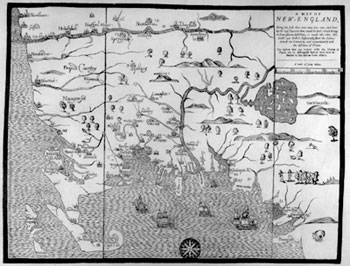
Woodcut past John Foster, Boston, 1677
This woodcut represents the earliest known map of New England from 1677. The mapmaker showed west at the height with northward to the correct.
The Arbella was 1 of eleven ships carrying Puritans to Massachusetts in 1630. This voyage was the largest always attempted in the English New World. The passengers of the Arbella left England with a new charter and a great vision. They were determined to be a beacon for the rest of Europe, "A Modell of Christian Clemency," in the words of future governor, John Winthrop.
They wanted to prove the rest of the world the correct and moral style to live. Winthrop stated their purpose quite clearly: "We shall be as a city upon a colina, the eyes of all people are upon us."
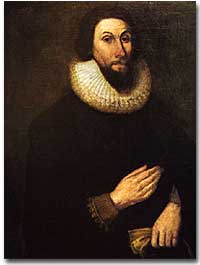
John Winthrop travelled to the New World aboard the Arbella. He was elected and dismissed every bit governor of the Massachusetts Bay Colony several times.
The Massachusetts authorities favored one church, the Puritan church. This model was popular in many European countries. Throughout Western Europe, ceremonious governments gave support to one Christian denomination. They granted them special powers and privileges, and persecuted men and women who held other religious views. When the first settlements began, Anglicanism (under the Church of England) was the established religion in England; in Scotland, Presbyterians had the highest status; the Dutch Reformed Church was the favored church building in the Netherlands; and the Roman Catholic Church dominated in France and Spain. During this fourth dimension, most believed that close alliances between religion and government benefited both the church and the country. Together, they could better promote morality, social harmony, and political stability.
You lot are a Puritan coming to America. You are asked about the fact that your colony will not have someone practicing a religion different from yours. The question you inquire is "How tin can you be a model of Christian Charity if you don't accept someone who believes differently than you lot?" How would you answer?
SKILLS: Analyze, Judge
Why did so many people believe in the need for a close relationship between church and country? For a century, Western Europe had seen many bloody conflicts between Catholics and non-Catholics, or Protestants. This led to problems both in everyday society and inside the government. Europeans had seen offset hand the consequences of religious dissent. Many of those affected by these conflicts immigrated to the New Globe, and brought their fears about religion with them. It is no surprise, then, that the founders of the first colonies in America speedily set up religious establishments like to Europe. While they gave their citizens the liberty to practise their founding organized religion, they refused to grant much religious liberty across that boundary.
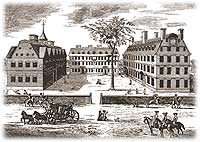
This engraving shows the Harvard campus equally it looked during the 18th century.
Ministers were highly revered by the colonists. Although ministers were not allowed to hold political office, they made many of the most important decisions. In 1636, Harvard Higher was founded to railroad train Puritan ministers. Information technology was the first college in North America.
By the end of the 1630s, every bit part of a "Not bad Migration," nearly 14,000 more than Puritan settlers came to Massachusetts. The colony began to spread. In 1691, Massachusetts Bay Colony absorbed Plymouth colony, creating i large territory.
Dissent in Massachusetts and the Settlement of New Colonies — The Model Begins to Modify
The colony needed more than a strong church to survive. Many dissenters — Christian men and women who were not converted — also lived within Massachusetts Bay. Not-Puritan settlers founded towns such every bit Marblehead. The Puritans allowed this considering they needed a wide diverseness of people and skills for their colony to succeed.
But there was not besides much room for religious disagreement in the Massachusetts Bay Colony. Puritans' faith was very strong and they spoke near it with fury. So when free thinkers began to speak their minds about religion and government, disharmonize occurred. Such was the case in Massachusetts Bay when Anne Hutchinson and Roger Williams spoke their minds.
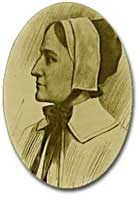
Anne Hutchinson was expelled from the Massachusetts Bay Colony in 1638 by Governor John Winthrop.
Anne Hutchinson was a securely religious woman. According to the way she interpreted the Bible, the ministers of Massachusetts were wrong to try to control social behavior. She thought their efforts to convert others to Puritanism conflicted with the doctrine of predestination. Predestination is the belief that God chooses who will become to heaven. She asked only: "If God has predetermined for me conservancy or damnation, how could any behavior of mine change my fate?"
This sort of thinking was seen every bit extremely unsafe. If the public ignored church authority, anarchy was more likely to occur. The power of the ministers would decrease. Soon later on Anne Hutchinson'south kickoff comments, over a group of community members began gathering in her parlor to hear her thoughts on the weekly sermon. Her leadership position every bit a woman made her seem all the more unsafe to the Puritan guild.
The clergy felt that Anne Hutchinson was a threat to the entire Puritan colony. They decided to abort her for heresy. In her trial she argued intelligently with Governor Winthrop, but the court found her guilty and banished her from Massachusetts Bay in 1637.
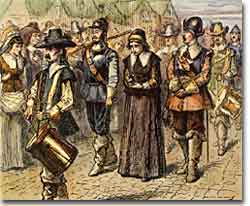
Mary Dyer was the first adult female executed for her religious beliefs in Massachusetts Bay Colony.
As an indication of how religiously strict Massachusetts was, an outspoken and previously banished Mary Dyer was hanged on Boston Common for the crime of beingness a Quaker.
Anne Hutchinson is banished and Mary Dyer is put to death. Requite one reason John Winthrop might take used to back up these actions. Requite one reason that Ann Hutchinson might have used to defend herself.
SKILLS: Judge, Create
Rhode Isle
Roger Williams was a similar threat. Williams was an important Protestant theologian whose ideas of religious freedom and fair dealings with the Native Americans resulted in his exile from the Massachusetts colony.
His ideas got him into major trouble in Massachusetts Bay. He became the first American to call for separation of church and state. He also believed in complete religious liberty, and so no single church should exist supported by tax dollars. Massachusetts Puritans believed at that place was 1 true organized religion, so his words were offensive and intolerable to them. Williams was summoned to the Full general Court in Boston for "erroneous" and "dangerous opinions."
Williams did not only have strong beliefs near religion. He claimed taking state from the Native Americans without proper payment was unfair. Ultimately, he was tried by the General Court and bedevilled of sedition and heresy. His sentence was to be banished.
In 1636, he purchased land from the Narragansett Indians and founded the colony of Rhode Isle. This colony was the commencement place in modern history where citizenship and organized religion were separated. Anne Hutchinson herself moved to Rhode Isle before a fatal relocation to New York.
Connecticut
Thomas Hooker was a devout Puritan minister. He also had some controversial opinions regarding the church building. Hooker objected to linking voting rights with church membership, which is what they did in Massachusetts Bay.
In 1636, his family unit led a group of followers west and built a boondocks known as Hartford. This would become the center of the Connecticut colony. In religious practices, Connecticut mirrored Massachusetts Bay. But it was dissimilar politically considering it allowed more access to non-church building members.
In 1639, Connecticut enacted the first written constitution in the western hemisphere. The model of authorities they used included an elected governor and a two-house legislature. These ideas were very innovative at the fourth dimension. The Connecticut constitution served equally a model for other colonial charters and even future state constitutions after independence was achieved.
In 1637, under the leadership of John Davenport, a 2nd colony was formed in the Connecticut River Valley. Information technology formed around the port of New Haven. Unlike the citizens in Hartford, the citizens were very strict about church membership and the political process. They even abolished juries considering at that place was no mention of them in the Bible. Most citizens accused of a crime simply reported for their punishment. Without a jury, at that place was no point to providing a defense force.
This map shows the area known as the Massachusetts Bay Colony during the 17th century. Settlers presently branched out and settled the areas that would be known every bit Connecticut and Rhode Isle.
Rex Charles Two merged New Haven into its more democratic neighbor in 1662.
If you lot were accused of a crime, would you report to a judge for sentencing, equally the people of Connecticut did, if those were the rules? Would information technology matter to you whether you did the crime or not? Would information technology affair whether you were innocent or not?
SKILLS: Analyze, Guess
Maryland

James Barry, 1793
In this engraving, Cecil Calvert presents his 1649 Act Concerning Religion to the ancient Spartan lawgiver, Lycurgus, while libertarians throughout history, including Ben Franklin and William Penn, look on.
Those who first settled in Maryland were besides fleeing religious persecution. In England in 1632, Cecelius Calvert, known as Lord Baltimore, was given all of the land between the Potomac River and the Chesapeake Bay. Lord Baltimore decided to grant religious freedom to the Catholics who remained in Anglican England and let them settle on the country. At this time in England, Catholics were nonetheless a persecuted minority. For case, information technology was illegal for anyone to exist married by a Cosmic priest. Lord Baltimore thought that his land could serve as a refuge. Only his intentions were non purely religious. He too hoped to brand a profit on the settlement and use of the land.
Maryland, named after England's Cosmic queen Henrietta Maria, was first settled in 1634. Although information technology was seen equally a refuge for Catholics to practice their faith, economic opportunity was the draw for many Maryland colonists. Consequently, most immigrants did non cantankerous the Atlantic in family units just equally individuals. The beginning settlers were a mixture of state gentlemen (mostly Catholic) and workers and artisans (generally Protestant). This mixture would doom the Cosmic experiment. With more than and more than workers immigrating, Catholics soon constitute themselves in the minority. Only the Maryland legislature all the same represented a pro-Cosmic cause.
Fearful that the Protestant masses might restrict Catholic liberties, the House of Delegates passed the Maryland Act of Toleration in 1649. This act granted religious freedom to all Christians. Like Roger Williams in Rhode Island, Maryland thus created these laws to protect religious liberty. Within ten years, notwithstanding, Protestants outnumbered Catholics in the legislature, which caused a lot of conflict betwixt the two groups. The Act of Toleration, all the same, is an important function of the colonial legacy of religious freedom. In fact, this Human action was very influential to the Kickoff Amendment in the American Bill of Rights.
Pennsylvania and New Jersey
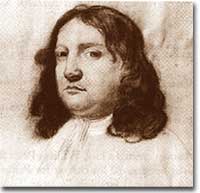
William Penn, founder of Pennsylvania ("Penn'southward Woods") and planner of Philadelphia, established a very liberal regime by 17th century standards. Religious freedom and practiced relations with Native Americans were two keystones of Penn'southward manner.
Pennsylvania was different. William Penn was awarded an enormous tract of country in the New Earth because Rex Charles Ii owed his father a huge debt. William Penn had a vision. He would create a land for people of his faith, the Quakers. They had suffered serious persecution in England. In 1681, his vision became a reality.
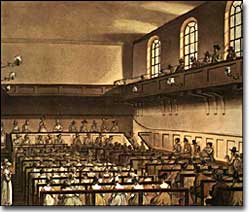
Central to the Quaker style of life was the Coming together Business firm. Here, Quakers would come together to worship. The to a higher place image depicts one of London's Quaker Meeting Houses.
Quakers, or the Gild of Friends, suffered profoundly in England. As religious dissenters of the Church building of England, they were targets of discrimination. But the Friends were also pacifists. This meant that they would not participate in any conflict. They would not fight in any of England's wars, nor would they pay their taxes if they believed the money would get to a military venture. They also believed in full equality. Therefore, Quakers would not bow downwardly to nobles. Even the king would not receive the courtesy of a tipped hat. They refused to accept oaths, and then their loyalty to England was always in question. Of the Quaker families that came from England to the New World, a majority of males had spent time in jail.
The Quakers of Penn'southward colony, established a very liberal regime for the seventeenth century. Religious freedom was granted to all and in that location was no tax-supported church building. Penn insisted on developing good relations with the Native Americans. Women saw greater liberty in Quaker lodge than elsewhere, and they were immune to participate fully in Quaker meetings.
Pennsylvania, or "Penn's Woods," benefited from the vision of its founder. He promoted his new colony throughout Europe, and as a effect, skilled artisans and farmers flocked to the new colony. Quakers owned New Jersey and the remnants of New Sweden, now called Delaware. With vast land, skilled workers, and Philadelphia equally its capital, Pennsylvania soon became the keystone of the English colonies.
Virginia and the South
The Church of England was the strongest in Virginia, where religious dissenters made upwards simply a minor minority until the 1750s. Simply the Church became weak as time went on. Information technology was hard to gain popularity for the church because the settlements in Virginia were so scattered. Also, the churches lacked real Anglican priests because they could not beget to pay them well. Prominent men in the colony led worship most of the fourth dimension to go on the Church agile. All Virginians were nonetheless required to attend public worship, and their taxes went back to the Church in England. After 1750, as Baptist congregations grew in that colony, some religious conflict occurred. Outspoken preachers were attacked by aroused mobs. Some were fined and imprisoned.
Elsewhere in the colonies, Anglicans enjoyed less official support. In the Carolinas also every bit in New York, New Jersey, and Delaware, Anglicans never fabricated up a bulk. They had e'er competed with ethnically various groups of Presbyterians, Baptists, Quakers, Dutch Reformed, and a diversity of German Pietists. Simply while the Church building of England never had the same concord over the colonies as the Puritans in Massachusetts Bay and Connecticut, it steadily spread through the South and Eye Colonies.
Thus, at the beginning of the 18th century in colonial America, religion was important and cardinal influence on the lives of the vast majority of people. Merely there were still some who rejected the idea that organized religion was central to a unified country and an orderly society. These leaders, including Roger Williams and William Penn, argued that it was the duty of governments to uphold liberty of judgment and censor.
Would you say that early America was founded every bit a "Christian nation"? Explain your thoughts.
SKILL: Estimate
- Why did so many people believe that society was all-time served past a close brotherhood between a single church and land government?
- How did freedom of religion and freedom of spoken language differ among the original colonies?
Source: https://www.ushistory.org/declaration/lessonplan/churchstate.html
0 Response to "What Can You Infer About Religious Diversity in 1750 From This Map?"
Post a Comment